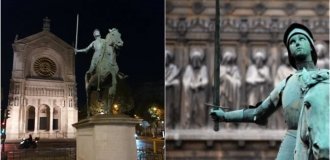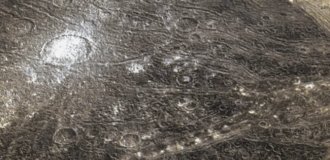How much horsepower can planes, trains and ships have (4 photos)
In relation to the world of cars, we are aware that, for example, 300 horsepower is quite a lot, and 80 is a Zhiguli or something very small and inconspicuous. Great. But what if we are not talking about the familiar world of cars, but about aviation, shipping or even space? What kind of numbers are they operating there and is there a well-established point of view in these areas that 500 “horses” is excess power?
AVIATION
The first plane (of the Wright brothers - that's right) needed 40 hp to take off, and now let's get straight to the revelations: modern planes, with hundreds of “horses,” are unlikely to even get off the runway. This tiny Cessna-182 weighing 900 kilos can be content with only 230 hp, but a commercial Boeing-737 with its 190 seats (by the way, such an average airplane by the standards of passenger carriers with wings) could use a couple of thousand “horses” . It has them: two CFM turbofan engines produce up to 12 tons of thrust each, which can be called a total of 25,000 horsepower at takeoff.
Need something more powerful? Well, the long-haul Boeing 777 has two stall-sized engines, 570,000 Newtons (roughly 45,000 horsepower) each. And the coolest of the Airbuses - the two-story, 280-ton Airbus A380 - has four engines and about 110,000 horsepower per lap.
By the way, this figure is not so far from what is produced by the six engines of the An-225, the largest transport aircraft in the world. An aircraft capable of taking on board anything up to a 200-ton power plant or a space shuttle and lifting it to an altitude of 12 km produces the equivalent of 111,000 horsepower. As they say, here's a Golf GTI for you, grandma.

VESSELS
In the navy (military or civilian) everything is a little simpler. To understand and evaluate the power of a watercraft (the Mistral aircraft carrier or a boat motor), it is not necessary to arm yourself with a calculator and a mathematics textbook and convert all these kilograms of force and kilonewtons into something familiar and tangible - as a rule, here the motor power is indicated in “conics” "
THE CRUISER "PETER THE GREAT" IS EQUIPPED WITH A NUCLEAR ENGINE WITH A POWER OF 140,000 HP. A simple example is fishing. To fish for carp from the middle of the lake, you need a boat. Please choose outboard motors from 2 to 300 horsepower. Of course, for larger hunts even a thousand forces are not enough. For example, the power of two General Electric gas turbine units of the American Arleigh Burke-class Carney destroyer (with guided missiles) sent by the US Air Force to the Mediterranean Sea is 108,000 horsepower. By the way, the afterburning power of the Russian missile cruiser Moskva, already on duty there, is slightly lower - about 90,000 hp. But the cruiser "Peter the Great", the pride of the Russian navy, is still more powerful - 140,000 "horses", however, mostly nuclear.
What about in civilian life? Well, the motor ship “Moskva”, which plies the waterways of the capital, is comparable in power to the hot Audi RS 3 or the weakest Mercedes-Benz Gelandewagen (despite the power plant of two V12 tanks). Larger things, like the Australian ferry The Cat, have thousands of horsepower (the aerodynamic The Cat has 38,000, like the 25 Bugatti Chiron). In the class of private superyachts, billion-dollar units are now in the lead, but you rarely find more than 40 thousand forces. And to tickle your nerves with really big numbers, the best solution is to look towards ocean liners. For example, the global giant Oasis of the Seas, equipped with three 1050-liter V12 and three 1400-liter V16, has a total volume of 7,350 liters and a total power of 136,900 horsepower. Touché!

TRAINS
Railways are a world of big numbers in terms of distances, but not power. Right? And if you remember the typical passage of a freight train through a crossing, when you have time to sleep while waiting for dozens of trains to pass? Same thing. Moreover, what is surprising: to pull almost a hundred cars of coal, oil products, wheelbarrows and other mail, the efforts of two to four heat or electric locomotives are enough. How much power do these strongmen have?
Well, perhaps the most famous and recognizable of the diesel locomotives is the shunting (read, for working over short distances) Bryansk TEM18. It is equipped with a four-stroke diesel engine and has the power of an entire Bugatti Veyron Grand Sport Vitesse - a respectable 1,200 horsepower. True, the speed of the “eighteenth” is not 400 km/h, but a rigidly constructed “weaving”. However, even this is almost an achievement for a 126-ton colossus.
6,000 “horses” - the numbers are more interesting. This is approximately the amount produced by two two-section mainline 2TE10V diesel engines - as a rule, this particular diesel locomotive can be found at the head of a long freight train consisting of tanks, platforms and hoppers. As for new products, for example, the hourly power of the new electric locomotive 2ES10 “Granit” (with a possible load of 7,000 tons) is 8,800 kW, which is equivalent to 12,000 horsepower that we are used to. And the famous Sapsan (or Siemens Velaro), running from Moscow to St. Petersburg and Nizhny Novgorod and capable of accelerating to 250 and even 300 km/h, has an output power of 8,000 kW - relatively speaking, like two electric trains traveling from Kazan station.

SPACE
If the debate about power has gone this far, then it is better to immediately forget about tens, hundreds and even thousands of horsepower. In a sphere built on the desire to overcome the gravity of the Earth, such things as chip tuning or boring a block for the sake of an extra 10 hp. - it’s just like zilch. Back in the 1960s (half a century ago, just a second), an oft-uttered phrase in the world of rocket science was - get ready! — “estimated 20 million horsepower.” Have you eaten?! The Proton rocket with its 900 tons of thrust produces 60 million “horses”. Saturn 5 - 3,000 tons of thrust and 200 million horses. And it doesn’t matter that these “horses”, in fact, say little about the characteristics of the rocket. The numbers are just space.






















